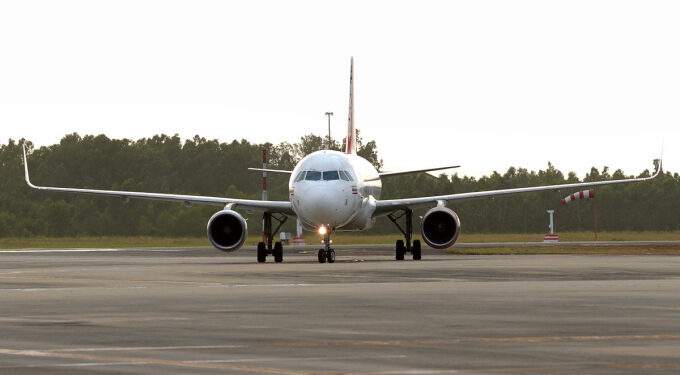Sun PhuQuoc Airways’ first Airbus A321 touched down in Vietnam on Sunday, less than two months after it secured its license.
The airline belonging to tourism behemoth Sun Group is moving swiftly to meet its ambitious timelines of starting ticket sales in October and flights by December.
 |
|
An aircraft seen at Da Nang International Airport in April 2025. Photo by VnExpress/Nguyen Dong |
It has set its sights high: It plans to fly eight Airbus A321 aircraft by year-end. It has been hiring personnel, including pilots and cabin crew. It has also secured a credit line from Vietcombank for buying 10 aircraft.
Sun Group envisions a resort focus for the carrier, combining transportation with premium tourism experiences. The airline plans to later on fly to destinations in China, Japan and South Korea.
Vietravel Airlines is making a strong return, bolstered by investment from conglomerate T&T Group after a period of difficulties due to aircraft shortages and financial constraints.
Since late June it has bought two aircraft and expects another soon to align with its new strategic shareholder’s shift from leasing to owning planes. It is targeting a fleet of at least 10 aircraft by year-end and expansion of domestic services.
Vietravel Airlines is also developing a dedicated cargo fleet. These developments are energizing Vietnam’s aviation sector amid strong recovery by the tourism and aviation markets post-Covid.
International tourist arrivals topped 12.2 million in the first seven months of 2025, a 23% year-on-year increase and 25% higher than in the same period in 2019, the golden year for Vietnamese tourism before the pandemic changed everything.
Rapid growth is now forecast following the government’s decision to waive visas for citizens of 12 European countries starting August 15.
Major additions to aviation infrastructure such as Long Thanh International Airport and expansion of Phu Quoc International Airport are opening up opportunities for new carriers.
The tourism recovery is also benefiting the established players.
State-owned Vietnam Airlines reported record profits of over VND6.68 trillion (US$254 million) for the first half of 2025, more than double its annual profits in the three years until 2019.
Budget airline Vietjet’s profits surged 65% year-on-year to VND1.6 trillion, its highest since Covid.
Bamboo Airways, despite challenges post-restructuring, nearly eliminated losses from aviation in the first half of 2025.
But the airline, which started flying in 2019, has scaled back from 30 to under 10 aircraft and reduced its route network, leaving the domestic market largely to Vietnam Airlines and Vietjet. At its peak, Bamboo Airways held an 18% domestic market share.
Despite the strong performance in 2025, Nguyen Trung Khanh, director general of the Vietnam National Tourism Administration, said a major challenge persists for domestic tourism in the form of high airfares, particularly during peak times.
This summer, for instance, ticket prices on many routes surged by 45% from last year.
The Bamboo Airways management admitted that new entrants and resurgent competitors are “breathing down their neck.” The airline currently operates seven aircraft, meaning Sun PhuQuoc Airways and Vietravel Airlines could surpass it before the end of this year.
In response to the changes the Bamboo Airways management emphasized the need for measures to enhance competitiveness, including maintaining service quality, ensuring complete flight safety, strengthening finances, and attracting new investors.
Meanwhile, Vietnam Airlines remains confident. “Competition is inevitable in a deeply integrated market,” chairman Dang Ngoc Hoa said.
Vietnam Airlines competes with over 50 international airlines operating to and from Vietnam, he said. “The entry of new airlines is an opportunity for Vietnam Airlines to innovate, enhance management and human resources and entrench its position as the national carrier.”
The airline plans to invest in technology and personnel, expand its domestic and international footprint, strengthen global partnerships, and diversify products and services to meet rising passenger expectations.





